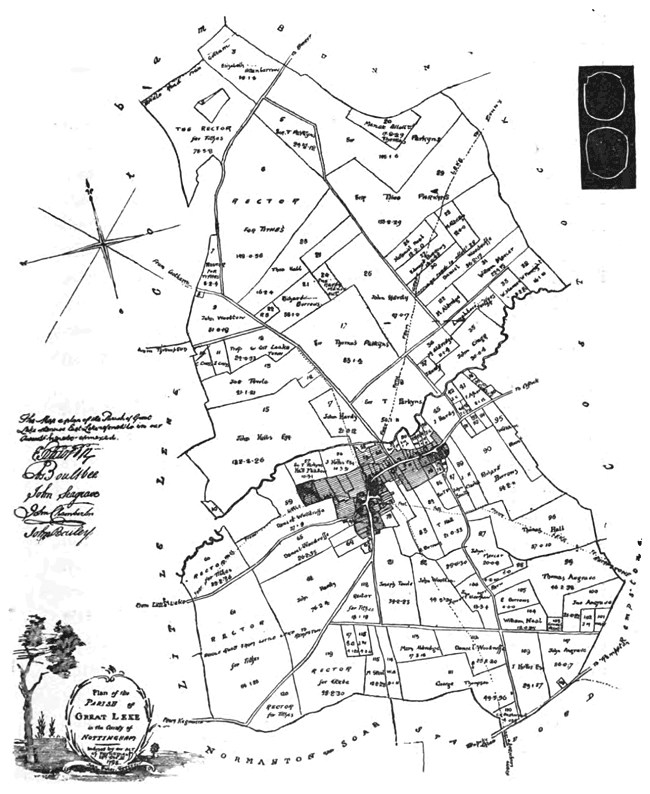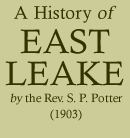< Previous | Contents | Next >

CHAPTER XI.
The Enclosure.
The East Leake commonable lands were enclosed under an Act of Parliament dated 38 Geo. III., the process occupying three years, 1798-1801.
A reference to the Terrier of 1748, printed in the Appendix, will enable the reader to appreciate the position of an owner of landed property before the Enclosure. In that the Rector is found to be possessed of eighty-three plots or allotments scattered over the whole area of the parish, a total holding of 40ac. 1r. 20p. If the Terrier of 1809, made after the Enclosure, is compared with this, the altered and more convenient position will at once be seen. The whole land which was given in lieu of these eighty-three plots was grouped together on the East side of Normanton Road, on the South border of the parish. The amount allotted (including an equivalent value for common rights) was 48a. 2r. 30p.

The Commissioners appointed under the Act were Edward Dawson, Joseph Boultbee, John Seagrave, John Chamberlin, and John Bailey—the latter being a professional surveyor.
The first work was to set out what roads, footpaths, and bridges were required. A plot of ground “not exceeding six acres” was allotted to the overseers for stone and gravel for the roads.
Next, the Rector’s allotment was determined, an equivalent being given for glebe and common rights, and 1/7 of the whole in lieu of tithes, great and small. In the Award the Rector is described “as such entitled to certain glebe lands and common right in the said open fields, lanes, closes, meadow's, pastures and commonable places, and to a Cottage with common right belonging thereto, and to all the great and small tithes arising reversing and increasing out of and from all the lands and grounds thereby intended to be divided and enclosed, and also to all the great and small tithe of all the yards, gardens, orchards, homesteads, and old enclosed land lying within the said parish of Great Leke otherwise East Leke.”
Other claims were then taken and settled, and opportunities were given for changing allotments by mutual agreement.
There are various stories still current in connection with the Enclosure, which may be recorded. It is scarcely necessary to add that they need not be accepted as matters of fact.
- There were various enclosed plots of land before the general Enclosure. One of these was owned by a certain man—Yerby by name. This field was a very choice possession in his eyes. In consequence he either gave it, or, more probably, it received the name of Yerby’s Heaven. This little enclosure was thrown into the whole amount of land divisible, and as the Commissioners did not see fit to assign the same to the old owner, Mr. Yerby lost his heaven on earth. The field connected with this story is situated on the West side of Gotham lane, and is now owned by Mr. Thomas Wilson.
- Where many interests are involved there is almost always some one or more of those concerned ready to think evil, and to forget the good national motto “Honi soit qui mal y pense.” In this case some thought that others received a little more than was their due. In particular, Daniel Woodroffe was thought to have gained a field beyond his rightful claims. It was suggested that he had been very hospitable to the Commissioners, and that the rum bottle had been used as a plea in his favour. Regardless of the consequences, the parishioners named this field, which is situated up Taft Leys Lane, Rum Bottle Close. It is known by this name to this day.
- It was natural enough for the stone throwers to fling a stone at Mr. Hastings, the Rector. There were those ready to say that the Rector received more than his due. This idea arose, no doubt, from a confusion of the tithe, and glebe claims. White’s Directory has been instrumental in perpetuating this charge, by stating that 466 acres of land were allotted in lieu of tithes. The true account is given in the Terrier for 1809, that 416a. 3r. 29p. were allotted in lieu of tithes great and small, and 48a. 2r. 30p. were allotted in lieu of glebe lands and common rights.
The Enclosure was instrumental in bringing a wide area of waste land into cultivation, and, as the gables of our farm buildings witness, gave a great impulse to building.
One of the minor disadvantages which followed it was, that some ancient roads and historical landmarks were obliterated.

